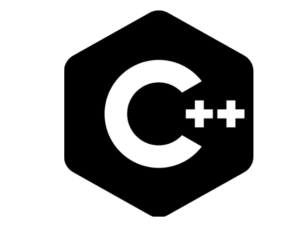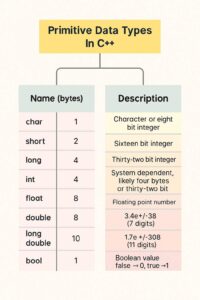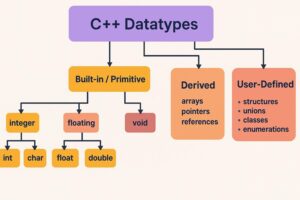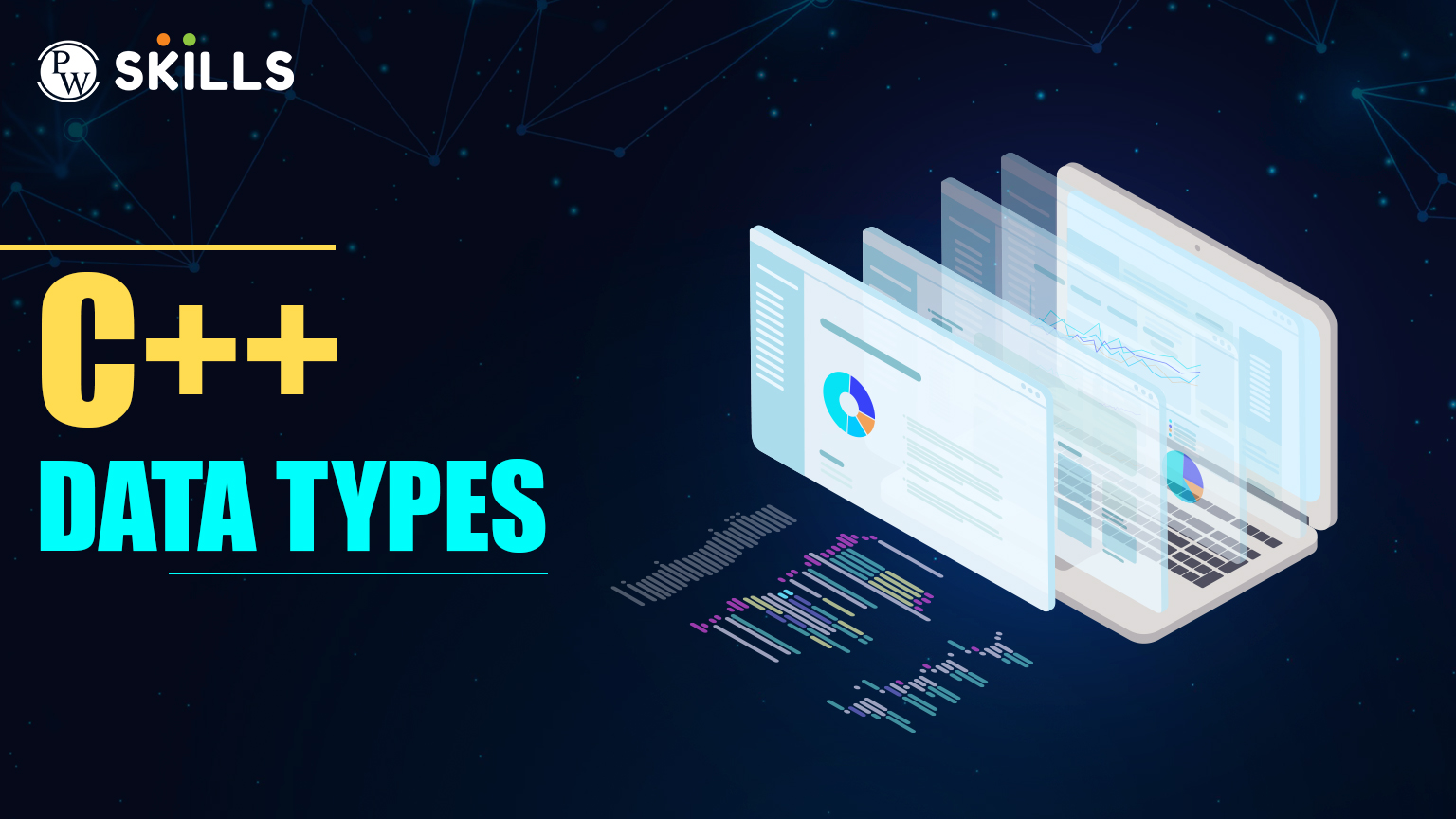Introduction to C++ Data Types
The first and probably the most difficult part of C++ is what C++ is about. Data types define what different types of values a variable can hold in C++ and how much space it would take in memory. Without them, C++ today may not have even been recognized as the structured, powerful language it is.
Imagine a grocery store that doesn’t know whether it deals with kilograms or liters-or even pieces. With coding without data types, that’s how it would look. C++ Data Types are the sets of rules that define whether something is an integer, floating-point number, character, or sometimes a custom-made entity like a student record.

In this case, this blog is not just another overview, but truly a 2025 complete and definitive guide. Topics include primitive, derived, and user defined data types with examples, modifiers, memory usage, best practices, mistakes to avoid, and so much more. At the end, you won’t memorize them just; you will learn how to use them with utmost efficiency in real-world programs.
Why Do C++ Data Types Matter So Much?
There is nothing in programming as golden as memory. Every variable you declare occupies space in RAM. The C++ Data Type you choose decides how many bytes are reserved and how the compiler interprets those bytes.
For example:
int a = 10; // Takes 4 bytes
double b = 10.5; // Takes 8 bytes
If you put 10.5 in an int, it would chop off the decimal. That’s a loss of precision, which can be fatal in scientific calculations or financial systems.
Great programmers don’t just write code that works; they write code that works efficiently. And that efficiency starts with choosing the proper C++ Data Types.
The Hierarchy of C++ Data Types
This is the conceptual hierarchy-a tree, so to speak:

Such a mental diagram helps you visualize how everything fits together-primitives as roots, derived types grow from them, and user-defined types let you create your own branches.
Primitive Data Types in C++ Data Types
Explanation
Primitive (or fundamental) data types are the basic building blocks of the language. Without them there could be no existing program. They correspond directly to low-level machine instructions, hence speed.
List of Primitive C++ Data Types
- int – Stores integers like -42, 0, 1234.
- float – Stores single-precision decimal numbers.
- double – Stores double-precision decimal numbers.
- char – Stores one character.
- bool – Stores logical values: true or false.
- void – Represents “nothing,” often used for functions.
Memory & Range Table
| Data Type | Size (bytes) | Typical Range | Example |
| int | 4 | -2,147,483,648 to 2,147,483,647 | int age = 20; |
| float | 4 | ±3.4e-38 to ±3.4e38 | float pi = 3.14f; |
| double | 8 | ±1.7e-308 to ±1.7e308 | double salary = 45892.99; |
| char | 1 | -128 to 127 | char grade = ‘A’; |
| bool | 1 | true / false | bool isOpen = true; |
| void | 0 | None | Used in functions |
Example Program
#include <iostream>
using namespace std;
int main {
int age = 22;
float gpa = 8.9;
double distance = 12987.678;
char section = ‘B’;
bool isGraduate = false;
cout << “Age: ” << age << endl;
cout << “GPA: ” << gpa << endl;
cout << “Distance: ” << distance << endl;
cout << “Section: ” << section << endl;
cout << “Graduated: ” << isGraduate << endl;
}
Output :
Age: 22
GPA: 8.9
Distance: 12987.7
Section: B
Graduated: 0
Note: 0 means false and 1 means true in C++ Data Types.
Derived Data Types in C++ Data Types
Explanation
Derived types are built from primitive types. These allow for more sophisticated structures through the collection of values, manipulation by memory, and function-based.
Common Derived Types
- Arrays: fixed-sized collection of elements.
- Pointers: variable that points towards the address in memory.
- Functions: blocks of reusable logic.
- References: Another name for an already existing variable.
Example: Arrays
int marks[5] = {90,85,78,92,88};
cout << “First student marks: ” << marks[0];
Example: Pointers
int x = 50;
int *ptr = &x;
cout << “Address of x: ” << ptr << endl;
cout << “Value at address: ” << *ptr;
Pointers make C++ Data Types special as it gives direct low-level access in memory unlike python or Java.
User Defined Data Types in C++ Data Types
Explanation
User Defined Data Types allow programmers to define new types that are not predefined. They are the heart of Object-Oriented Programming in C++.
Examples
- struct – Grouping variables together.
- class – Combining variables and functions.
- enum – Named constants.
- typedef/using – Custom type names.
Example: Class
class Employee
{
Public:
string name;
int id;
double salary;
void display()
{
cout << “Name: ” << name << “, ID: ” << id << “, Salary: ” << salary;
}
};
int main() {
Employee e1;
e1.name = “Raj”;
e1.id = 101;
e1.salary = 50000;
e1.display();
}
This is how C++ Data Types enable us to map real world entities into computational models.
Modifiers in C++ Data Types
C++ lets you modify primitive types to extend their range or restrict them. These are called type modifiers.
- signed / unsigned
- short / long
Example:
unsigned int age = 25; // Only positive values
long double distance = 9876543.21;

Type Casting in C++ Data Types
Sometimes you need to convert one data type into another. This is called type casting.
int a = 5;
double b = (double)a / 2; // Explicit casting
Type casting ensures the smooth operations of different C++ Data Types.
Storage Classes and C++ Data Types
When you learn about C++ Data Types, simply knowing the size or range of a variable is not enough. Memory allocation and the period of existence of a variable in a program also matters – and that’s when storage classes come in. A storage class in C++ defines the scope, lifetime, and visibility of a variable.
Automatic Storage with C++ Data Types
By default, local variables are assigned to the auto storage class, meaning that they only exist inside the function and cease to exist when the function ends. For example, a declared int in a loop is automatically removed once the loop is executed. Automatic storage saves memory and prevents name clashes or other conflicts in much larger programs.
Static Storage with C++ Data Types
The variable remains the same even after a function stops executing if declared static. For example, C++ Data Type’s static int x does not reset the count each time it runs the function-it will retain its last value. This is ideal for counters, caches, or remembering states across function calls.
Extern and Global C++ Data Types
You may want your variable to be accessible in all files of that project. To achieve this, extern storage class variables can be declared globally but used in different source files. For example, ‘extern float interestRate;’ will declare it in one file and access it in another.
Register Storage with C++ Data Types
For the older systems, register was used to tell to compiler to store a variable variable into the CPU register for faster access. Although it is done automatically by modern-day compilers, one should know that the old coderegister int counter; was meant for speed optimization.
Common Mistakes with C++ Data Types
Even expert programmers commit mistakes when it comes to working with C++ Data Types. Here are some snags to avoid:
Mixing Signed and Unsigned C++ Data Types
Perhaps the most common trap is mixing signed and unsigned numbers. For example:
unsigned int x = 10;
int y = -5;
if (x > y) { /* … */ }
Here y is converted into an unsigned integer, which can give quite surprising results. So, be very careful not to mix your types.
Overflow and Underflow in C++ Data Types
When we store a number out of its defined range in a data type, the allocated space will heavily influence what happens. Example: Assume a char which can hold values from -128 to127. Now put in value130, it might give an output like -126. Such behavior can be disastrous bugs in calculations.
Precision Loss with Floating-Point C++ Data Types
Float or double variables may not always store decimal values correctly. For example,0.1 plus 0.2 may not equal 0.3 due to how floating points are stored in memory. In general, professionals handle such cases, especially in finance and scientific programming.
Incorrect Use of User-Defined C++ Data Types
Structures and classes can introduce bugs when their values are not initialized at the time of creation or are not perceived as having memory allocated by the programmer. For instance, shallow copies in objects may lead to memory leaks.
Real-World Applications of C++ Data Types
The theory of a C++ Data Type becomes more amusing when applied in a real-time project.
Gaming and Graphics Development
Primitive and derived C++ Data Types are used intensively in video games. Integers count scores, floats control object movement and physics, and structures contain the game state. Even superior graphics libraries like Open GL and Unreal Engine are built on a C++ foundation.
Banking and Financial Applications
User-defined data types, such as structures and classes, are applied in the banking concept to represent accounts, transactions, and customers.Critical floating-point precision is extremely important when calculating interests in large amounts of money.
Embedded Systems and IoT
Microcontroller memories are usually very restrictive. Therefore, the selection of the right C++ Data Types like unsigned char or short is always important to use less memory and store data effectively. A single mistake can put the system’s whole life at risk or even waste memory usage.
Artificial Intelligence and Machine Learning
Even in today’s C++ standards, where frameworks for modern AI operate, C++ Data Types represent one of the most basic elements. Their representation usually refers to matrices, weights in neural networks, or huge datasets. Efficient float, double, and even custom-defined types are needed for building high-performance computational models.
Also Read:
- C Programming Language Syllabus (2025)
- C++ Function: A Comprehensive Guide with Syntax and Code Examples
- C++ Coding Interview Questions: Top 50 Q&A You Must Prepare in 2025
- Variables in C++: Declaration, Initialization, Rules, and Reference Variables (2025 Variables)
Related Reads
Learn the Basic Structure of a C++ Program
Understanding The Top 10 Features Of C++ Programming Language
PW Skills DSA C++ Course
This is the Complete Guide to C++ Data Types, covering everything from primitive types to derived and user-defined types as well as modifiers, type casting, and storage classes. Choosing the right data type lays the foundation for the program’s efficiency, accuracy, and scalability. Master now, and advanced concepts like templates and inheritance in C++ will be much easier.
Level Up Your Programming Skills with PW Skills DSA C++ Course. Learn from industry experts on Data Types, Algorithms, and Problem Solving. Be sure that almost all learning is not only in theory but through time in real-world projects, you code.
Not necessarily—it depends on the compiler. But it usually takes 1 byte. Yes, but it can generate unexpected outcomes. Comparing signed int with unsigned int might cause an error. Both create type aliases, but using is favored in modern C++. Storage classes are important for controlling variable lifetime and scope. For a static int variable, it will keep its value for successive calls to a function, as an example.C++ Data Types FAQs
Is the bool always of 1 byte in C++ Data Types?
Can I mix signed and unsigned C++ Datatypes?
What is the difference between typedef and using in C++ Data Types?
How do storage classes affect data types?

